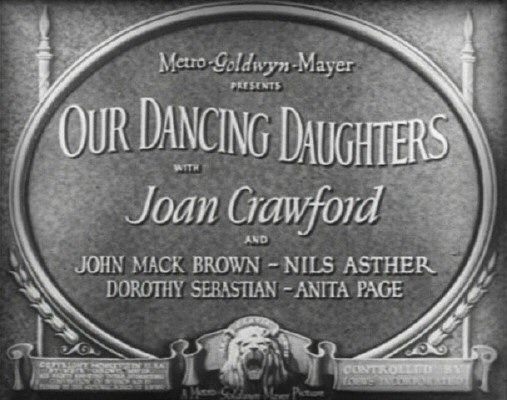
The Best of Everything
Encyclopedia Entry • Films Main
Our Dancing Daughters
1928

Critics' Reviews • Our Reviews • Movie Posters • Misc. Images • Lobby Cards • Books
Click here to see photos from the film.
US release: 9/1/1928.
VHS release: 9/5/2000. DVD release: 9/21/2010. Blu-ray release: 1/10/2023. Cast: Joan Crawford (as "Diana Medford," aka "Dangerous Diana"), Johnny Mack Brown, Dorothy Sebastian, Anita Page, Nils Asther, Dorothy Cummings, Huntley Gordon, Evelyn Hall, Sam De Grasse, Edward Nugent, Eddie Quinlan. Credits: Story and scenario: Josephine Lovett. Director: Harry Beaumont. Camera: George Barnes. Titles: Marion Ainslee and Ruth Cummings. Editor: William Hamilton.
Awards: 1928/29 Academy Award nominations: Best Cinematography (Barnes), Best Writing Achievement (Lovett).
Plot Summary: Even those who can't recall the plot of the silent Our Dancing Daughters (and there admittedly isn't much to remember) can never forget the indelible images of Joan Crawford tearing loose with one Charleston after another. Since everyone in the film is rich, the wild parties that dominate Our Dancing Daughters are played out in the biggest mansions this side of Windsor castle. Jazz-baby Crawford is actually a good girl despite her hedonistic lifestyle. She wants to marry young millionaire Johnny Mack Brown, but he is tricked into marriage by deceitful Anita Page. After drinking herself blotto at a party, Anita brags about her subterfuge, then conveniently tumbles down a long flight of stairs to her death ("Poor little rich girl" is the general consensus of opinion amongst the many servants, though few in the audience are shedding any tears). Thus, Crawford is able at last to link up with Brown, presumably to live happily ever after. Released with synchronized music and sound effects, Our Dancing Daughters manages to convey the "noise" of the Roaring '20s without sound, relying instead on inserted shots of art-deco statuary and the bubbling-over performance of Joan Crawford in the role that made her a star. Crawford was reunited with her Dancing Daughters co-stars Anita Page and Dorothy Sebastian in two follow-up films (not sequels), Our Modern Maidens (1929) and Our Blushing Brides (1930). ~ Hal Erickson, All Movie Guide
Notes: • This was Joan's star-making role. After the film's release, box office grosses for Loew's theaters soared, as did the volume of fan-mail for Joan (as did her salary). (Ultimate Star) • The film was based on the story "The Dancing Girl," which originally was serialized in Hearst newspapers. (US) • Titles considered for the film: Dancing Girl, These Modern Girls, Dancing Daughters, and These Naughty Times. On April 16, 1928, the title Our Dancing Daughters was finalized. (US) • In surveys taken by the Payne Fund from 1919 to 1933 to gauge the influence of films on teenagers, this film was the one most often cited by teens. (US)
IMDb page Silent Era page Wikipedia page |
|
Mordaunt Hall in the New York Times (October 8, 1928) Hundreds of girls and young women were attracted yesterday to the Capitol Theatre and their presence probably was due chiefly to the title of the film feature, "Our Dancing Daughters," a chronicle concerned with the wild young people of this generation. The Capitol now is equipped for the reproduction of sounds, which fact was only too patent yesterday, for while "Our Dancing Daughters" is not furnished with dialogue, it has a musical accompaniment, several love songs, stentorian cheering and, at the end, a chorus of shrieks. Whether this audible mixture adds to the entertainment value of the picture is a matter of opinion. It assuredly detracts from the action of the picture in some of the sequences. The romantic melodies that accompany the love-sick looks and the violent embraces of the principal characters are reminiscent of the oldtime singing to lantern slides. The enthusiastic cheering impresses one as though the producers wanted to make the most of sound, and the shrieks in the closing scenes come from mute figures to whom terror has suddenly given tongues. There is nothing startingly novel about "Our Dancing Daughters," for while there is an undeniable vivacity to many of the scenes, the action is not particularly well portrayed and it is frequently anything but conservative. Cocktails, flasks and mad dancing appear in quite a number of episodes. It is quite unnecessary to depict an intoxicated girl, as is done for considerable length in this film. Presumably it is to point a moral, for the young woman falls to her death down a flight of stairs. The wide-eyed Joan Crawford, who is attractive in many of the scenes, figures as one of the dancing daughters. After an unusually violent terpsichorean performance, this young woman, known as Diana, suddenly takes an interest in Ben Blain, a stranger to the hectic life but the son and heir of a multi-millionaire. Harry Beaumont, the director, has among his worthy sequences in this film, one in which the fractious Diana tells her companion, Beatrice, that she is in love. This incident is quite appealing and it caused great glee yesterday afternoon. But Diana is doomed to be disappointed, for a little blonde, the daughter of a mercenary mother, succeeds in capturing the heart of the peculiarly susceptible Mr. Blain. This fair-haired minx, named Anne, soon leads Mr. Blain to the altar and poor Diana is left to brood over a blighted life. Josephine Lovett, who wrote "Our Dancing Daughters," cannot be accused of much subtlety in ridding Mr. Blain of his tempestuous bride. John Mack Brown is sympathetic as Mr. Blain. Dorothy Sebastian is appealing as Beatrice. Anita Page gives a fairly good portrayal of her idea of a dancing daughter. Bland Johaneson in the New York Mirror (1928): Joan Crawford, as the girl who was free and wild but maintained her ideals, does the greatest work of her career. She has a typical Clara Bow role and she gives a lively run around for first honors as a modern flap. Joan has beauty, charm and more refinement than the trim-legged Bow. She makes you believe she's straight even through the torrid, questionable scenes she is required to play. She also shows a snappy Bow figure and she can dance a mean varsity drag.
New York World (1928): Of Miss Crawford it may be predicted that in case her managers continue to find just such breezy little comedies for her she will realize what apparently has been her ambition for at least two years, and get going as a star in her own right. She has good looks, sprightliness, intelligence and a good sense of humor. She dances with great grace and versatility and she knows when--and how--to call a halt.
Motion Picture Classic (December 1928): That the public isn't tired of the jazz-mad story is proved in "Our Dancing Daughters," which, while it has nothing of consequence in its plot, succeeds in proving entertaining because of its atmospheric opulence, its colorful incident and the personalities of the players. It has a title with more than its share of magnetism. Consequently, it will appeal to the younger set. What is revealed of plot of has been looked over time and again, but its obvious points will be overlooked in the general excellence of the production and the spirit with which it moves. And there's where Joan Crawford steps up and takes a bow. She it is who vies with another girl to win a gilded son of wealth. And there's a lot of animation in those scenes in which she and Anita Page strut their stuff. The picture is beautifully mounted, and the array of shots help in making one forget the plot's shortcomings. It is synchronized in places to bring emphasis to the incident and most of the synchronization is in harmony with the detail it expresses. Nils Asther and John Mack Brown and Edward Nugent carry out the principal masculine assignments and do very well. You should like "Our Dancing Daughters" it is fairly hot.
Motion Picture Magazine (September 1928): Pictures are certainly getting better. Don't miss this one if you really want to be entertained. It has practically everything. Youth, pep, good-looking women, attractive clothes, and an awfully good story. The titles are funny. It's all very smart and modern, and Joan Crawford looks and acts better than she ever has. The cast also includes Dorothy Sebastian, Nils Asther, Eddie Nugent, Johnny Mack Brown, and other celebrities. And the big thrill is the small new blonde, Anita Page, who, in her second part, steals the picture from Joan Crawford and gives a performance that would be unusually good even for a big star. The story is about three modern girls, and how they get husbands and how they lose them.
Photoplay (August 1928): Gals with gold-digging aspirations can see this and learn. The story depicts life in the younger set and deals with the struggle of two gals for one lad. The presentation of youth is a lovely one, what with a yacht club and cocktails. The main issue is: Will the rich young hero succeed in rectifying the tragic mistake he made by choosing the wrong girl? Light romance - and good. One thrill you won't forget, nor the girl - Anita Page. Hers would be the outstanding performance if Joan Crawford and Dorothy Sebastian were not also in the picture. Nice restraint in the work of John Mack Brown, leading man. Nils Asther's fervent kisses not too good, but his jealousy is real. Eddie Nugent, a prop-boy turned actor, is well started.
Delight Evans column in Screenland (October 1928)
NotComing.com by Matt Bailey (2009)
|
If you've seen Our Dancing Daughters and would like to share your review here, please e-mail me. Include a photo of yourself or avatar, as well as a star-rating (with 5 stars the best), along with any of your favorite lines from the film.
|
Rating:
Our Dancing Daughters (1928) is a story of three Jazz Age
young women. Joan plays "Dangerous" Diana Medford, who likes to
party, but is at heart a good girl. Contrast this to her bestie
Beatrice (Dorothy Sebastian), who is thought to be a good girl, but hides a
dark secret. (After re-watching the movie recently and discussing it with
other Joan fans, it seems the most likely candidate for her shameful
secret is pre-marital sex---in the 1920s, a major no-no.) The last of the
trio is Ann (Anita Page), who is outwardly good, but at heart a
gold digger, trained for a life of avarice by her even more detestable
mother (Kathlyn Williams, who was a big star a generation
earlier).
When an eligible
young millionaire, Ben (Johnny Mack Brown), appears on the
scene, romantic sparks fly with Diana, but he frets about Diana's party
girl image, which the devious Ann uses to drive a wedge between them and initially
snatch Ben
for herself. Overall, this was
easily the biggest role for Joan up to this point in her career. There's
no leading man to support. This movie is all her. Even in the
subsidiary thread about Bea, her ugly secret, and its impact on her
husband (Nils Asther)---who was not the man who deflowered her---the
movie focuses on how Joan is there to support her friend. This movie may
also be the birth of the Joan Crawford formula: She's dressed
glamorously, is made up impeccably, appears among sumptuous Art Deco sets, and
is shot with unfailing flattery. No less an authority than F.
Scott Fitzgerald anointed her the ultimate expression of the Jazz Age
woman after seeing ODD. Our Dancing Daughters is the movie that catapulted Joan Crawford to stardom. Add in Joan's grit and determination to improve her skills, adapt to multiple movie genres, and persevere in a business heavily biased toward youth, and ODD is why we're still discussing the ultimate movie diva almost a century after she was first captured on celluloid and a half century after her last movie. For that reason alone, it deserves at least 3 stars. Add in another star because it's a good story that is well told, acted, lit, decorated, and shot. Anita Page does a great job as the villain; I wanted to smack her on at least a half dozen occasions. I also like Dorothy Sebastian as Bea. She's lovely. I wish that she had a longer and more successful career. JMB is a tad stiff, but that seems to have been his way. (Oh well, he was a good place holder among Joan's leading men until Gable came along!)
 Michael
Lia (May 2019) Michael
Lia (May 2019) Rating:
This is my first Joan Crawford
silent movie review, and I really wasn't that into it. I love The Unknown, for instance, but I'm not that sure about the rest of
her silent films. To me, the Silents were made for Greta Garbo and Charles
Chaplin and Buster Keaton and D.W. Griffith and F.W. Murnau and Fritz Lang. Films
like The Wind and Sunrise. The cast must have had fun making
the film. Johnny Mack Brown is too nice, maybe even dull, but if I were Joan,
he's the guy you'd want! Dorothy Sebastian, I always enjoy, and Anita Page can
be a real bitch and pain, but here she is not holding back, performing with
gusto; she is great as the really dangerous girl. Nils Asther and Edward Nugent
are also busy and working hard in this new medium.
Rating:
After nearly 4 years of playing, for the most part, a variation of "The Girl" to a host of MGM leading men in various comedies, dramas, even Westerns, 1928's Our Dancing Daughters finally gave Joan Crawford the undivided attention and spotlight she'd been working toward.
Joan plays "Diana Medford" ("Dangerous Diana" as she calls herself), a young, rich party girl with a wild reputation based on her devil-may-care facade. Diana's always the life of the party, quick with the wisecrack, willing to flamboyantly strip off her skirt if the music calls for it. A new man in town, the millionaire Ben Blaine (Johnny Mack Brown) is both fascinated by and somewhat frightened of Diana's wild behavior. In steps Diana's conniving rival Ann (Anita Page), who's really a fast gold-digger but puts on an innocent-little-girl front to seduce Ben. (One nicely done moment at the opening party: Diana and Ann are both trying to attract Ben. When drinks are offered, Diana flirtily dips her finger into a glass and teasingly licks it while making eyes at Ben; Ann sees this and intentionally takes the opposite tack: "Oh, I never drink!" Ben, in turn, seems befuddled.)
The movie is snappily energetic, fast and fun and risque. Aside from the above-mentioned scene with Diana sans skirt, there are also plenty of other close-up leg shots, including the opening scene, shot only from the waist down, with Diana simultaneously dancing while pulling on her undies! Equally risque are the references to Diana's friend Beatrice's (Dorothy Sebastian) "wanton past"---Beatrice honestly tells her husband-to-be (Nils Asther) that she's been with other men. He's jealous and makes a scene or two, but the fact that this is not a primary plot point and that Beatrice is portrayed sympathetically indicates the "modern," rather enlightened pre-Code place that the picture's coming from.
Diana loses Ben to Ann shortly after Ann coos to him: "I can't be daring and free with men. I'm not a 'modern.' I want a husband and babies and to be worthy of them." The heartbroken Diana later cries to her parents: "What's wrong with me? I'm not a liar---a cheat---I've been decent---And I've lost---Why? Men want flattery, trickery---lies!" These issues that the movie raises are interesting and especially timely for 1928 (though still relevant today), when women's roles in society were very much in flux and young women were surely looking for outside indicators of "appropriate" behavior.
Diana's outwardly independent spirit combined with her inward determination to not play games or win a man via trickery struck a chord with the film-going public of the time. (Or maybe it was just that the film's modern party spirit attracted young people of the time.) Joan's fan mail increased ten-fold and the film was a huge hit, known today as the performance that made Joan Crawford a star. (Sidenote: In a poll taken in 1933, delinquent girls were asked what characters in film they most admired. Joan's "Diana" was the most frequently cited, primarily for her "sense of fair play." That in itself speaks far more than I can say here about the immediacy and impact of Joan's performance.)
Sociology aside, Joan's a whirlwind of energy in Daughters, obviously happy to finally have the chance to unleash her own naturally exuberant personality onscreen rather than simply playing the tame good-humored-but-still-proper sidekick to a male lead. But, while her spunkiness is the focus of the early scenes, her later more subtle scenes, when she's quietly mourning or openly distraught over Ben, are equally effective and charismatic. (I did catch her overacting once, but just once!) Joan's co-star Anita Page also gives a standout performance as the smarmy man-stealing Ann; she's silkily smooth when she's making nice and equally good when she reveals her true wicked self in her final drunkenly mocking confrontation scenes.
Our Dancing Daughters is a fun watch, and interesting: Historically, knowing how this launched Joan into superstardom, as well as its being honest in its portrayal of sexual dynamics. But also because of Joan's thoroughly modern portrayal of a girl who manages to have a good time while remaining true to herself in the face of public (and her man's) disapproval. I can see why this movie, and Joan, were a big sensation.
|



Above: A 78 rpm Columbia record label for "I Loved You Then As I Love You Now," and sheet music for the song. At right: A US theater glass slide.
Below: NYC Capitol Theatre program for its sound picture debut on 9/29/28. Click to see bigger pictures of whole 8-page program.
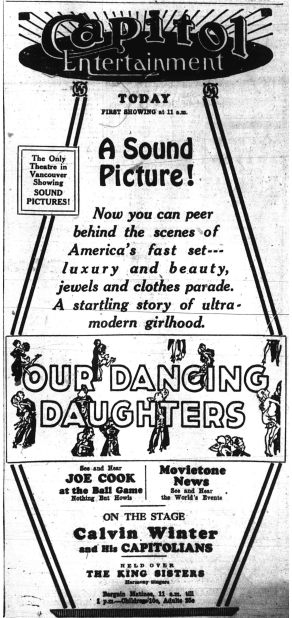
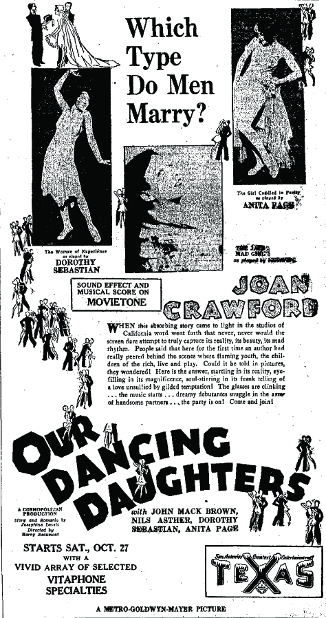
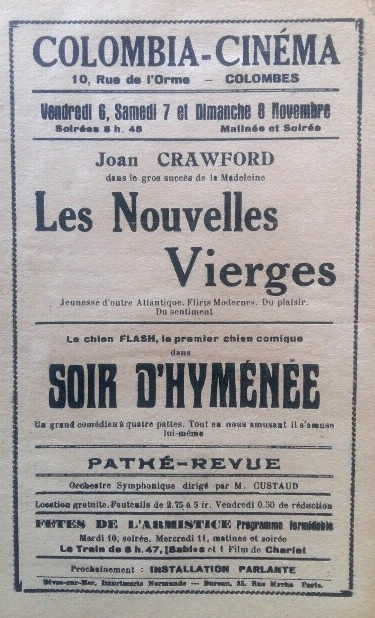
Above: Newspaper ads from Vancouver, Canada, and San Antonio, Texas. And a program from a Paris suburb.
Below: Japanese flyer; and two US window cards.

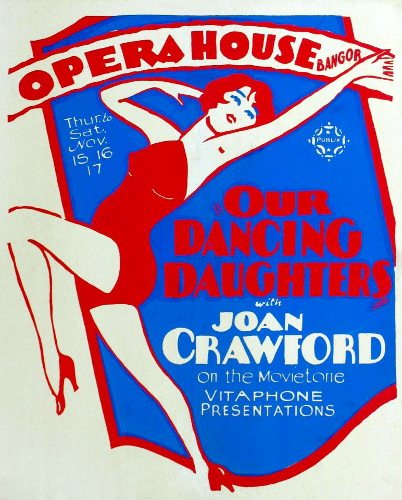
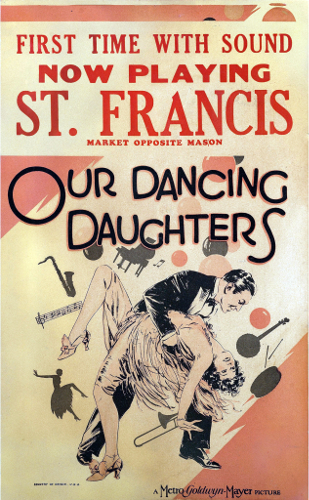
Below: A US herald.



Below: A herald from Uruguay.


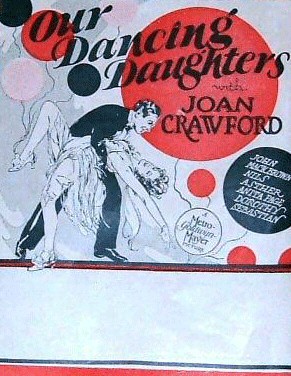
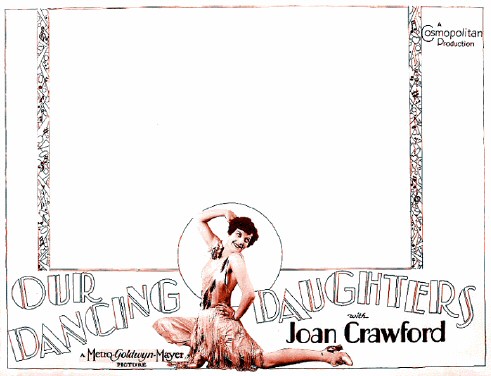
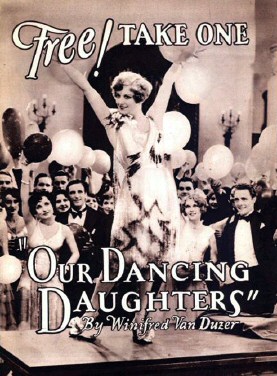
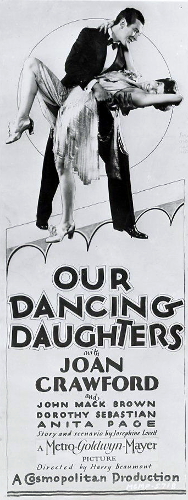
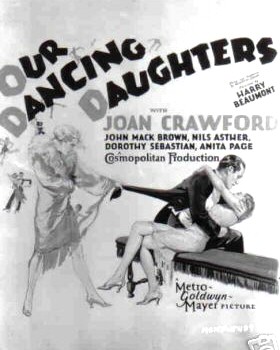

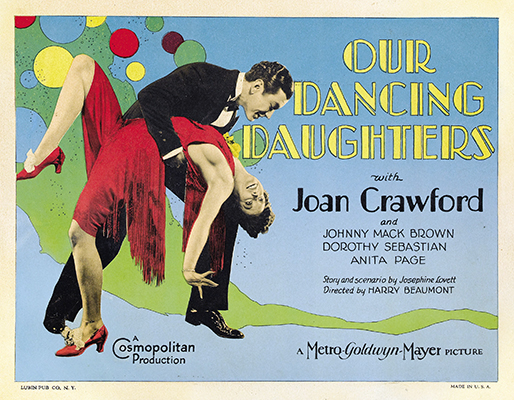





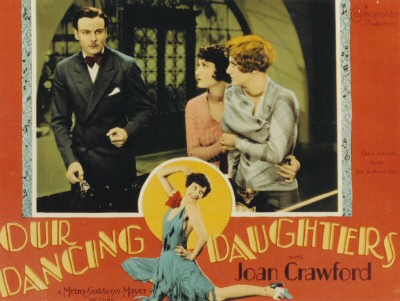
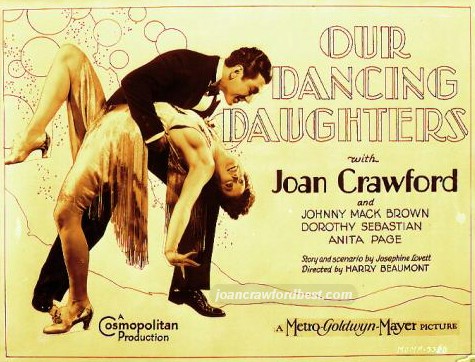
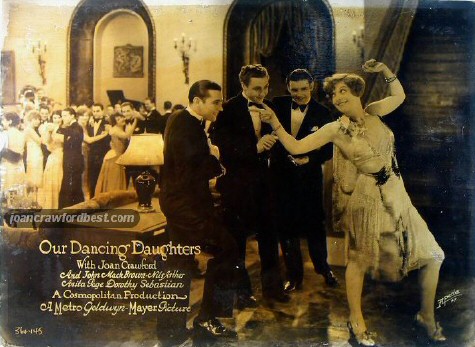
Below: 1928 novelization by Winifred Van Duzer (US and UK); and (right) French novelization by Charles Coulonges.
See the Books Related to Joan Movies page for bigger pictures and more info.
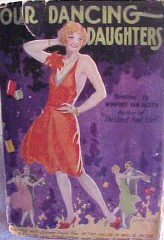
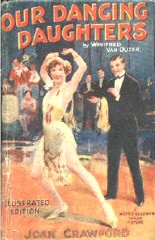

The Best of Everything
